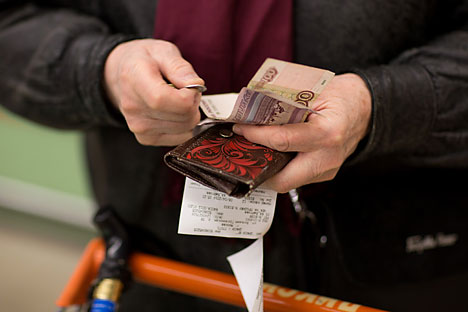
In 2015 the average amount of debt on all segments of crediting increased, including a growth of 85 percent for credit cards, 39 percent in POS credits (Point of Sale), 31.5 percent in cash credits, 19.5 percent on auto-credits and 8.5 percent in mortgage credits.
Getty ImagesIn the past year, arrears on loans have reached record levels. Borrowers are finding it more difficult to repay their loans due to the steep devaluation of the ruble and corresponding drop in real income at their disposal. Experts also believe banks are giving people less credit due to these circumstances.
While some Russians have adopted a more responsible attitude toward their expenses and started saving money, the most desperate credit addicts are turning to “debtor anonymous” groups.
In 2015, the share of arrears on consumer loans reached a record high of 11 percent, according to the Gaidar Institute, one of the country’s leading economic scientific research institutes. Previously, the highest indicator was 9.1 percent. Moreover, delayed payments have increased from 10 to 20 percent, said Mikhail Khromov, director of the laboratory of financial studies at the Gaidar Institute.
According to the National Bureau of Credit Histories (NBCH), the largest database of credit histories in the country, Russians currently owe more than 10 trillion rubles ($154 billion) in retail debt, while arrears on loans stand at 1 trillion rubles ($15 billion).
The main reason driving the accumulation of debt is the sudden drop in the population’s income, experts say.
“This leads to poor servicing of the borrowers’ credit obligations,” says Alexei Volkov from NBCH.
Data from the Sekvoya Credit Consolidation collecting agency confirms the problem. In a survey in the second quarter of 2015, the company asked 3,000 debtors why they missed their loan payments. Forty-three percent of respondents attributed the problem to their worsening financial position.
“As a result of the deteriorating macroeconomic situation, the population’s real disposable income decreased by 1 percent in 2014 and in 2015 it is expected to decrease by 8 percent. Consequently, more resources are used paying for primary goods and less are left to pay back the loans,” says Sekvoya Credit Consolidation president Elena Dokucheva.
As a result, banks have been giving out less credit. The volume of consumer credit in the January-October 2015 period declined by 35 percent to $51.8 billion in comparison with the same period last year.
In Alexei Volkov’s opinion, a subjective factor plays a major role: debtors’ inaccurate assessment of their prospects.
“In order for this not to happen, it is necessary to check your credit history, assess your potential and ask for credit only when it is really unavoidable,” Volkov says.
Another group particularly vulnerable to the debt crisis are those lacking knowledge about loan repayment or suffering from impulse control. Uncontrollable spending is comparable to an alcoholic’s addiction, says the director of the Psychoanalysis and Business Consulting Department at the Higher School of Economics, professor Andrei Rossokhin.
“These people have the inner ‘I’ of a child who cannot wait and doesn’t understand that taking out a loan entails responsibility,” Rossokhin says.
Some have found solace in the Society of Anonymous Debtors, founded in 2011 and modeled on American Debtors Anonymous, which was established in the 1970s.
“We’ve discovered that loans are a sickness that with time doesn’t disappear but on the contrary, progresses,” reads the society’s website. “It is impossible to cure the disease but it can be stopped.”
This was true for Victoria from Moscow, who several years ago invested in the FOREX MMCIS Group investment company by taking out a bank loan and borrowing from her friends for a total of about 3.7 million rubles ($57,000). In 2014, Victoria received a letter from MMCIS saying that the company was initiating bankruptcy procedures. As a result, together with interest, Victoria still owed five million rubles ($77,000).
Victoria credits the Society of Anonymous Debtors with her recent increase in income and the fact that every month she can make bank payments and return her friends’ money.
“I have already stopped considering myself a victim, and my life has become less impulsive than before,” Victoria told the RBC Daily newspaper.
Another participant of the society, Maria, calls herself a spendthrift.
“Earlier, I would always borrow money and almost 70-80 percent of my income went towards paying off my debt. The remaining 20-30 percent was not enough to live on and therefore I had to keep borrowing,” Maria says.
Attending the society helped Maria pay off her debt and even save up for a vacation, she says. “However, after my vacation I again started borrowing,” she says. “And I had to return to the group.”
All rights reserved by Rossiyskaya Gazeta.
Subscribe
to our newsletter!
Get the week's best stories straight to your inbox